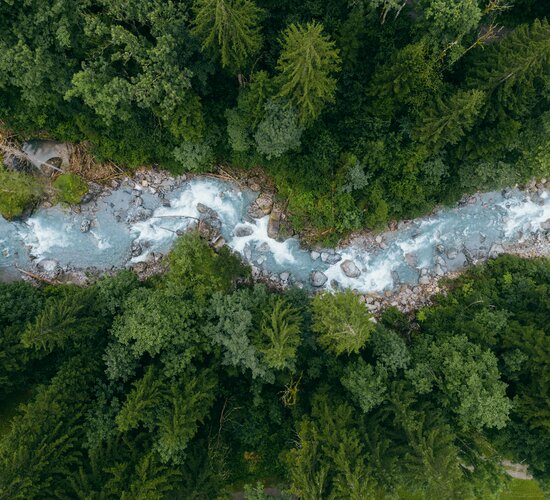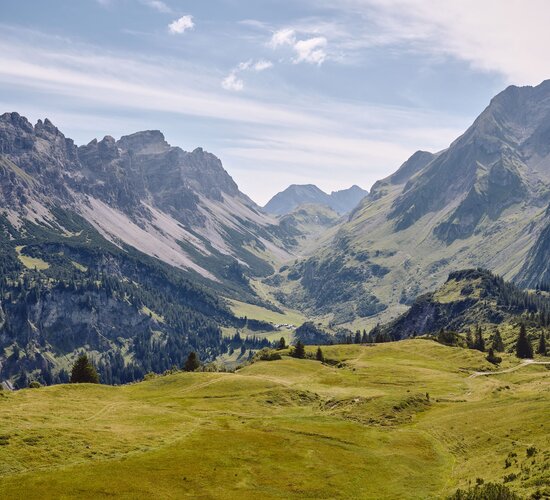UNESCO Biosphere Reserve
Using nature without harming it
The Große Walsertal is a high mountain valley of great originality and tranquillity. With an area of almost 192 km², 90 % of which is natural landscape, it stretches from 580 to 2,704 meters above sea level. Here, the connection between man and nature is carefully nurtured.
The valley has been a UNESCO Biosphere Reserve since 2000 - a distinction that stands not only for nature conservation, but also for sustainable regional development, environmental education and research. In this model region, the preservation of biodiversity is combined with a gentle, responsible lifestyle that respects and conserves natural resources.
Biosphere reserves such as the Große Walsertal offer answers to the pressing questions of our time: How can we lead a life that is in harmony with nature and at the same time meets our needs? In this landscape, nature is not only protected, but also consciously experienced and enjoyed - always with the aim of preserving its original beauty.
In a biosphere reserve, people and nature should interact with each other and complement each other positively. Using nature without harming it - that is the motto of a biosphere reserve.

About the work in the biosphere reserve
Großes Walsertal and the Galapagos Islands: Together in the global network of UNESCO biosphere reserves.
Mission statement and significance
In addition to the natural model and the zoning, the population model is also a prerequisite for the application to become a UNESCO biosphere reserve.
In 1999, almost 70 people from the Großes Walsertal participated in the development of the mission statement. It contains principles and development goals divided into twelve areas of life and economy. The biosphere reserve mission statement is evaluated every five to seven years and still forms an important basis for the development of the region and is incorporated into the management plan of the UNESCO Biosphere Reserve Großes Walsertal.
By actively involving the population in the development and evaluation of the mission statement, it has been possible to bring important players on board from the very beginning. This was and is a very important aspect for the dissemination and consolidation of the biosphere reserve idea.
Function
The functions and tasks of a biosphere reserve encompass all areas of the population's life and economy.
- Nature conservation
UNESCO biosphere reserves are ecologically unique. They stand for a high diversity of species and habitats. This diversity is to be protected in biosphere reserves and preserved through nature-friendly management.
Examples of this diversity in the Großes Walsertal are the colorful flower meadows, which are home to a wide variety of flora and fauna, or the large number of forest habitats, such as in the Gadental nature reserve, which is one of the biosphere reserve core zones. The intact natural and cultural landscape in the Großes Walsertal was a key prerequisite for the designation as a biosphere reserve.
- Sustainable regional development
In addition to the protection of biodiversity, the sustainable development of the region is also one of the tasks of UNESCO biosphere reserves.
In line with the Seville Strategy, the involvement of the local population is a decisive factor. Since UNESCO recognition in 2000, numerous projects and initiatives have been launched in the Großes Walsertal that focus on the sustainable development of the region and nature-friendly economic practices.
- Research & environmental education
Research lays the foundations for the development of the region - in ecological, economic and social terms - and strengthens the understanding of the relationship between man and nature.
Education for sustainable development conveys values as well as knowledge and behaviors that contribute to a future worth living and positive change in society.
- Preserving culture
Culture includes everything that has been created or shaped by man. The preservation of the cultural landscape in the Großes Walsertal is closely linked to customs and the knowledge gained over many generations.
The awareness of 700 years of Walser history, the preservation of dialect, traditional costume and customs are equally important. At the same time, it is important to preserve the knowledge gained from experience in the management and sustainable use of the cultural landscape and transfer it to the present day.
There are around 60-70 plant species per square meter in a rough pasture. Around 10 insect species live on each plant species. This means that rough pastures have a higher biodiversity than rainforests and, alongside riparian forests, are among the most species-rich habitats in Europe.
Zoning
Biosphere reserves are divided into three zones in order to be able to fulfill their diverse tasks:
- Development zone
The development zone (2,587 ha, 13.5 %) is the living, economic and recreational area for people. This includes the entire permanent settlement area of the Großes Walsertal.
- Maintenance zone
The maintenance zone (13,331 ha, 69.5 %) consists of a cultural landscape characterized by traditional three-tier farming, which is a habitat for animals and plants - and should remain so through near-natural agriculture. This includes above all mountain forests, alpine meadows and traditionally used mountain pastures.
- Core zone
The core zone (3,304 ha, 17 %) consists of ecosystems that should develop as far as possible without human intervention. These include the Gadental and Faludriga-Nova nature reserves, the Lutz mountain river, the Kirschwald-Ischkarnei area, the Tiefenwald moor complex and the Rote Wand, the highest mountain in the valley.
biosphärenpark.haus: Discover, enjoy, shop
Want to find out more about the biosphere reserve? In the biosphärenpark.haus in Sonntag - directly opposite the Sonntag-Stein valley station - an exciting exhibition, a cozy bistro and a store with regional products await you. Come and have a look!

Biodiversity and protected assets
The UNESCO Biosphere Reserve combines the protection of rare habitats such as mountain meadows and limestone moors with sustainable development. The Gadental European nature reserve is home to endangered species such as the rock ptarmigan and lady's slipper orchid. A place that preserves biodiversity and brings it to life!
